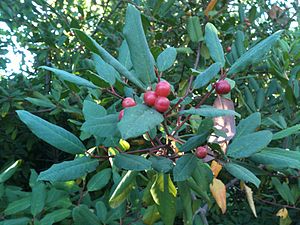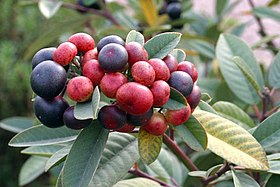Frangula californica
| Frangula californica | ||||||||||||
|---|---|---|---|---|---|---|---|---|---|---|---|---|

Frangula californica |
||||||||||||
| Systematics | ||||||||||||
|
||||||||||||
| Scientific name | ||||||||||||
| Frangula californica | ||||||||||||
| Eschsch. |
Frangula californica (formerly known as Rhamnus californica out english California coffee berry, California buckthorn ) is a plant from the family of Buckthorn family . It isnative towestern North America . The TNC classifies the species as safe ("G5").
description
Frangula californica is a shrub one to four meters high. Their appearance varies depending on the subspecies . Under suitable conditions, tree-like forms up to four meters high can appear. Shrubs one to two meters high are more common.
The branches have a reddish tint and young twigs are often red in color. The alternately arranged evergreen leaves are dark green on top and paler green on the underside. In humid habitats the leaves develop thinner leaf blades, which are smaller and thicker in dry biotopes.
The flowers, 0.125 in (3.2 mm) in diameter, stand in groups in the leaf axils. They have five petals and five shorter sepals. The plant blooms in May and June. The fruit is a juicy stone fruit that can be green, red, or black. It is only a little less than an inch long and contains two seeds that are similar to coffee beans .
distribution
F. californica is native to California , the southwestern United States, and the state of Baja California in Mexico . She is a neophyte in Hawaii .
The plant grows in oak forests and in the chaparral as well as in many other habitats in its range. Individual plants can reach an age of 100… 200 years.
Taxonomy
Synonyms
The following synonym is known:
- Frangula californica (Eschsch.) A. Gray
Subspecies
The following subspecies of Frangula californica have been described:
- Frangula californica subsp. californica - English California coffeeberry ; widespread in western California; Fruits with two seeds, branches red, leaves with noticeable veins.
- Frangula californica subsp. crassifolia - english serpentine hoary coffeeberry ; endemic to the high altitudes of the northern California coastal mountains , on serpentine soils .
- Frangula californica subsp. cuspidata - English Sierra hoary coffeeberry ; Southern Sierras, Transverse Ranges , Peninsular Ranges .
- Frangula californica subsp. occidentalis - English Western California coffeeberry ; on serpentine soils in northern California and southwest Oregon , the Klamath Mountains, and northern California Coast Mountains; Fruit with three seeds, twigs brown, leaves with inconspicuous veins.
- Frangula californica subsp. tomentella - English hoary coffeeberry
- Frangula californica subsp. ursina - English desert hoary coffeeberry ; endemic to the San Bernardino Mountains and Sky Island in the Mojave Desert .
ecology
The shrub belongs to many plant communities and grows in many biotope types such as the Californian chaparrals and forest landscapes, the coastal shrubbery and oak forests. It occurs in forests such as the damp oak forests on the coast, coastal redwood forests, evergreen mixed forests, and mountain conifer forests.
F. californica is found together with Ceanothus leucodermis ( English chaparral whitethorn ), Heteromeles arbutifolia ( English toyon ), Rhus trilobata ( English skunkbush ), Rhamnus crocea ( English redberry ) and Toxicodendron diversilobum ( English western poison oak ). In the scrubland of the mountains it grows together with many species of bearberry ( English manzanita ).
The species reproduces sexually via seeds and vegetatively via budding. After forest fires or deforestation, they are generally sprouted again from the root crown. Propagation via seeds is usually common in old stands. Seeds are produced from the age of two or three years. The maturity falls in autumn. The seeds are often dispersed by birds, which are attracted by the fruit; some plants are so "cleared" by birds that some seeds always fall under the parent plant.
The perennial plant becomes the dominant species in many habitats , e.g. B. in coastal forests. Unless forest fires interrupt its growth, the shrub grows to some size and becomes so spreading that it shadows other plants. In the event of a fire, the plant can suffer serious damage, but it will quickly sprout again from the root crown, which in this case is covered with buds. It then reaches its previous size relatively quickly.
Parts of the plant, including the foliage and the fruits, provide food for wildlife such as mule deer , black bears and many resident and migratory birds, but also domestic animals .
use
Cultivation
Frangula californica is grown as an ornamental plant in tree nurseries to be used in wild plant, dry and natural gardens . The cultivation takes place in large pots and containers. It is also used in near-natural landscaping and in renaturation ecology .
It is also used for erosion control and is usually resistant to deer . It is particularly valuable as a food source for pollinators such as native butterflies and bees .
Cultivars
Cultivars of the kind that are used as ornamental plants are u. a .:
- Frangula (Rhamnus) californica 'Eve Case' - English Eve Case coffeeberry ; smaller and more compact (1… 2 m high, 1… 1.5 m wide), with denser foliage and larger fruits than the wild form. Introduced in 1975 by the Saratoga Horticultural Foundation.
- Frangula (Rhamnus) californica 'Leatherleaf' - English Leatherleaf coffeeberry ; with black-green foliage.
- Frangula (Rhamnus) californica 'Mound San Bruno' - smaller leaves, denser and more compact than the wild form; specially adapted to horticultural conditions.
- Frangula (Rhamnus) californica 'Seaview' - a ground cover variety.
Food and medicine
The berries contained in the seeds make an excellent caffeine-free coffee surrogate that, with its mocha notes, surpasses chicory coffee in taste.
Although the plant itself is very similar to a coffee plant, the succulent berries do not. However, they can be used in jams and jellies.
The Indians of the North American west coast had different uses for the plant. Parts were used as a traditional medicinal plant. Several tribes of California Indians ate the fruit fresh or dried.
The Muwekma Ohlons used the leaves to treat dermatitis caused by urushiole . The Kumeyaay had a similar use for the bark. The Kawaiisu used the fruit to treat burns and similar wounds. The bark has been used as a laxative by many tribes .
In the language of the Konkow , a Maidu people , the plant is called pä and pö, among others .
Individual evidence
- ↑ a b c d Frangula californica . In: Jepson (TJM2) . Retrieved April 5, 2015.
- ^ A b c Frangula californica in the Germplasm Resources Information Network (GRIN), USDA , ARS , National Genetic Resources Program. National Germplasm Resources Laboratory, Beltsville, Maryland.
- ↑ a b Frangula californica . USDA. Retrieved May 4, 2015.
- ↑ a b c d Flowering Plants of the Santa Monica Mountains , revised. Edition 2000.
- ^ Frangula californica - (Eschsch.) Gray . In: NatureServe . 2012. Retrieved May 20, 2019.
- ↑ a b c d e f g h N. E. McMurray: Rhamnus californica . In: Fire Effects Information System . USDA FS. Rocky Mountain Research Station, Fire Sciences Laboratory, 1990.
- ^ A b Frangula californica - Subspecies and Varieties . In: Calflora . Retrieved May 20, 2019.
- ↑ Frangula californica subsp. californica . In: Calflora . Retrieved April 5, 2015.
- ↑ Frangula californica subsp. californica . In: Jepson . Retrieved April 4, 2015.
- ↑ Frangula californica subsp. crassifolia . In: Jepson . Retrieved April 4, 2015.
- ↑ Frangula californica subsp. cuspidata . In: Calflora . Retrieved April 4, 2015.
- ↑ Frangula californica subsp. occidentalis . In: Calflora . Retrieved April 5, 2015.
- ↑ Frangula californica subsp. occidentalis . In: Jepson . Retrieved April 5, 2015.
- ↑ Frangula californica subsp. tomentella . In: Calflora . Retrieved April 5, 2015.
- ↑ Frangula californica subsp. tomentella . In: Jepson . Retrieved April 4, 2015.
- ↑ Frangula californica subsp. ursina . In: Jepson . Retrieved April 4, 2015.
- ↑ a b c Frangula (Rhamnus) californica (Coffeeberry) . In: Las Pilitas Horticulture Database . Retrieved May 21, 2019.
- ↑ a b Frangula californica (California buckthorn, California Coffeeberry) . NPIN — Lady Bird Johnson Wildflower Center. Retrieved May 21, 2019.
- ↑ a b c d Frangula californica (California Coffeeberry) . In: "Gardening with Natives" blog . California Native Plant Society. September 28, 2010. Retrieved April 4, 2015.
- ^ Protocol Information for: Frangula (californica) . In: Native Plants Network.org . Retrieved May 21, 2019.
- ↑ a b Frangula (Rhamnus) californica . Theodore Payne Foundation. Archived from the original on December 4, 2017. Info: The archive link was automatically inserted and has not yet been checked. Please check the original and archive link according to the instructions and then remove this notice. Retrieved May 21, 2019.
- ^ Carol Bornstein, David Fross, Bart O'Brien: California Native Plants for the Garden . Cachuma Press, Los Olivos, CA 2005.
- ↑ Frangula (Rhamnus) californica 'Eve Case' . In: San Marcos Growers horticulture database . Retrieved May 21, 2019.
- ↑ Frangula (Rhamnus) californica 'Leatherleaf' . In: San Marcos Growers horticulture database . Retrieved May 21, 2019.
- ↑ Frangula (Rhamnus) californica 'Mound San Bruno' . In: San Marcos Growers horticulture database . Retrieved May 21, 2019.
- ^ A b Hank Shaw: Exploring California Coffeeberries . Retrieved May 21, 2019.
- ^ A b Dan Moerman: Frangula californica . In: Native American Ethnobotany . Retrieved May 21, 2019.
- ^ VK Chesnut: Plants used by the Indians of Mendocino County, California . United States Government Printing Office, 1902 (Retrieved August 24, 2012).
Web links
- USDA Plants Profile for Frangula californica (English)
- Frangula californica - Photo Gallery of the University of California (English)


